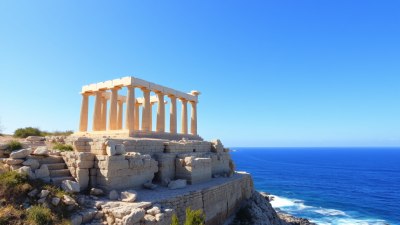The Temple of Poseidon in Greece Listens for the Tide’s Return
Explore the historical significance and beauty of the Temple of Poseidon in Greece, a marvel by the sea.

Image created with Flux Schnell
The Temple of Poseidon, perched majestically on the cliffs of Cape Sounion in Greece, is one of the most iconic and atmospheric sites in the country. Built in the 5th century BC, this ancient temple dedicated to the god of the sea, Poseidon, stands as a testament to the grandeur of classical architecture and the beauty of its natural surroundings. Overlooking the azure waters of the Aegean Sea, the temple offers breathtaking views and a sense of tranquility that seems to resonate with the rhythm of the waves. In this article, we shall explore the historical background, architectural features, and cultural significance of the Temple of Poseidon while listening for the tide’s eternal return.
Historical Background
The Temple of Poseidon was erected during the Golden Age of Athens, a period marked by tremendous cultural and political achievements. Its construction began around 444 BC under the guidance of the statesman Pericles, who aimed to showcase Athens' power and influence. The site was chosen because of its strategic location, acting as a beacon for sailors navigating the Aegean Sea. It is believed that the temple replaced an older temple that was destroyed by the Persians in 480 BC, further emphasizing its enduring significance.
Legends and myths surrounding Poseidon add depth to the site’s historical importance. According to ancient Greek lore, Poseidon was known for his volatile temperament, capable of both nurturing calm seas and unleashing terrifying storms. Sailors would often pray at the temple before embarking on their journeys, seeking the god's favor and safe passage. The temple therefore not only served as a religious center but also as a vital location for maritime commerce, representing the close connection between the sea and the livelihood of ancient Greeks.
Architectural Features
The Temple of Poseidon is renowned for its stunning Doric architecture, characterized by its robust columns and simplistic elegance. Originally, the temple was constructed with 34 columns, although only 15 columns remain standing today, indicating its size and majesty. Each column rises to a height of about 8 meters and is made from local marble, imparting a sense of permanence and connection to the Aegean landscape. The proportions of the temple reflect the principles of harmony and balance that defined classical Greek architecture.
One of the most striking features of the Temple of Poseidon is the exquisite detailing that remains visible on its columns and friezes. Visitors can observe the muted remnants of sculptural reliefs that once adorned the temple, depicting various mythological scenes and figures from Greek mythology. The positioning of the temple on the cliff edge enhances its visual impact, making it appear as if it were a natural continuation of the landscape itself, harmonizing with both earth and sea.
Cultural Significance
The Temple of Poseidon is not only a monument to ancient architectural prowess but also a symbol of Greek cultural identity and heritage. It has inspired countless artists, poets, and writers throughout history. Lord Byron, the famous English poet, is known to have inscribed his name on one of the temple's columns, a testimony to its cultural allure even in the 19th century. Many contemporary visitors find themselves captivated by the haunting beauty of the site during sunset, when the sun dips below the horizon, casting a golden glow on the ruins and the sea.
In addition to its historical and aesthetic value, the temple has also served as a focal point for various cultural activities and local traditions throughout the years. Festivals and religious ceremonies dedicated to Poseidon were likely held here, illustrating the site's continued importance in the lives of the ancient Greeks. Today, it remains a popular destination for tourists and pilgrims, symbolizing the eternal draw of the sea and the richness of Greek mythology.
Visiting the Temple Today
Guided tours are available, providing insights into the temple's architectural details, historical significances, and the legends that surround Poseidon. Visitors can take their time exploring the site, capturing photographs that pay homage to the stunning backdrop of the sea and sky. The temple's strategic position makes it a popular spot for sunset viewing, with many traveling just to witness the sun setting behind the ancient columns, an experience that seems to embody the spirit of both time and nature.
Conservation Efforts
Educational programs and exhibitions surrounding the site also play a role in raising awareness about the significance of preserving such monuments. By engaging the public in discussions about history, archaeology, and conservation, these initiatives foster a deeper appreciation for the Temple of Poseidon and its role in Greek identity.











